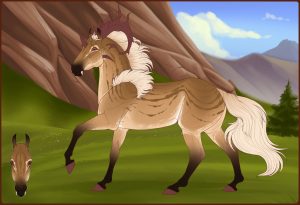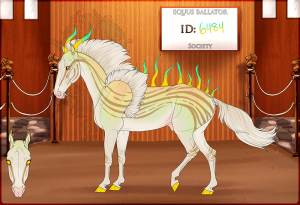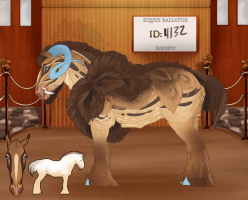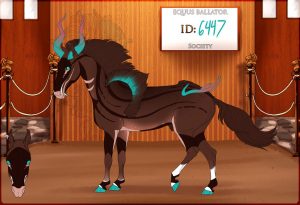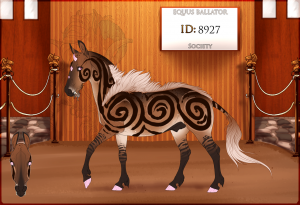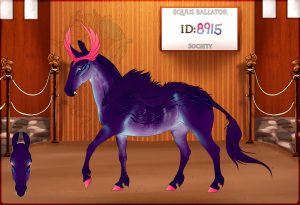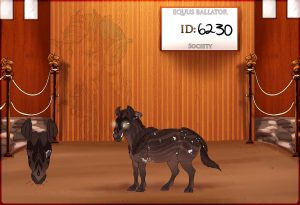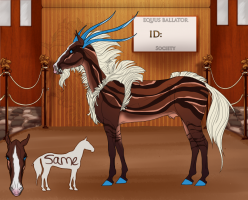Archetain
The Archetain Mutation - nAtn | AtnAtn
Derived from the Greek words Arche (Beginning) and Tania (Stripe), Archetain is a highly diverse and intricate mutation. Archetain has several subtypes and boasts a wide spectrum of interaction with other genes. If your Ballator has two (2) or more genes that interact with Archetain, you may use them all and combine them into a unique design, or you may choose one (1) dominant.
Ballators with Archetain all have the capacity to have solid, blotchy, or soft underbelly markings as well. Only Arctic Ballators may have mane stripes produced by Archestain, and only upon their downy body manes, not shoulder, neck, back, or tails.
Archetain has eight (8) distinct subtypes, four (4) for both Homozygous and Heterozygous genes. When writing out an Archetain phenotype, it is useful to write what variant is being expressed, for example: Black Archetain (pard) Calva Hornstripe
Primitive Archetain (Heterozygous nAtn)
Primitive Archetain will almost always have lighter belly, face, neck, and rump markings.
Stripes follow the topline and curve of the body in flowing, blotchy lines.
Stripes may be numerous or few with thin to medium line thickness.
Pard Archetain (Heterozygous nAtn)
Pard Archetain is noticeable by its very thick, stout, Clouded Leopard like stripes.
Like Primative Archetian, Pard often has a lighter belly marking. Pard also features lighter stripes under the dark stripes in the same color as the belly marking.
Pard also features heavy facial or leg markings.
Whorl Archetain (Homozygous AtnAtn)
Whorl Archetain is noticable by its large swirling markings that are concentrated around the shoulder, belly, and rump.
Whorl is similar to a tabby cat in appearance.
Lighter colored belly markings can sometimes be intermingled within the Whorl shapes.
Interactions with Other Mutations
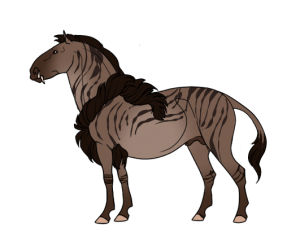
While some Africans have been seen to posses the Archetain gene, it is rare. On an nAtn horse, the gene interacts with the stripes that are already on the African Ballator, causing them to become blotchy. They to not follow the topline exclusively, like normal Archetain, but flow like Zebra stripes, albeit not as abundant as them.
For AtnAtn Africans, the gene will express normally.
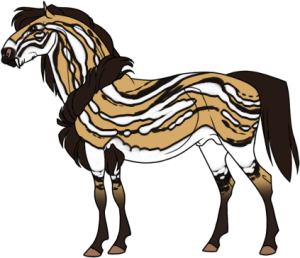
Most commonly, Clownfish will turn the base stripes into a white color, and surround them with a dark edge. Darker stripes radiating from the border may be added as well.
However, clownfish can also express normally, with the gene covering the mutation. The manes of the horse will not turn white unless a paint gene is added to the Clownfish.
The only exception to this is the AtnAtn variant Smoke, which is recessive to Clownfish. Clownfish will appear normally on top of Archetain.
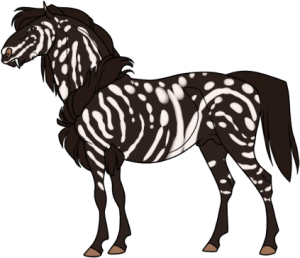
When accompanied by Dominant White, the mutation takes on a confused, broken appearance, no matter what the base variant is.
The stripes turn white and break in small and large segments, often in chains, with spots around them as well.
The white areas that touch the mane may or may not turn the mane white.
The only exception to this is the AtnAtn variant Smoke, which is recessive to all paint/white genes. Dominant White will appear normally over top of the Smoke pattern.

Perhaps the most stunning of interactions, Archetain + Dotted sooty creates a variety of patterns. The variant of the Archetain and it’s dominant/recessive state does not affect the mutation, but rather, the state of the Dotted Sooty gene.
nDs will cause stripes to band together on the topline vertically, with some stray spots and stripes perhaps floating around this pattern.
Add in a paint or white gene to nDs, and the white spots may become entrapped within the thick stripes, or paint can express normally.
DsDs will cause beautiful rosettes typical of the Double Dotted Sooty gene, often with the Archetain pattern appearming almost normally around it. The stripes will often connect with the rosettes.
When a paint gene is added, the “filling” of the DsDs may turn white, not the striping. Or, paint can express normally
The only exception to this is the AtnAtn variant Smoke, which is recessive to Dotted Sooty. DS will appear normally on top of Archetain.
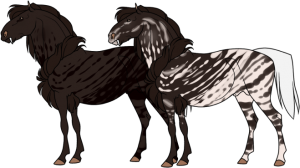
The interaction between Okapi Dun and Archetain is stunning to say the least.
For nOk, the stripes are dark. While a lighter underbelly from Archetain is possible, no lighter stripes will be seen. There is minimal facial striping as well. Thin stripes on the forehand gradually become thicker and closer near the hindquarter, until all stripes mingle and Okapi-Dun stripes appear to be ‘cut out’ of the pattern. Tails will still turn white.
The same is for OkOk, but facial striping will usually be abundant or minimal and the stripes will be white. No dark stripes permitted.
The only exception to this is the AtnAtn variant Smoke, which is recessive to Okapi. Okapi will appear normally over top of the Smoke pattern.

When accompanied by any white marking (other than dominant white or minimal white), Archetain may express in one of two ways.
It may either allow the white marking to pass over top of it, or it will ‘contain’ the white marking in it’s stripes, with no visible remnant of the white marking’s original form. Some darker stripes may surround the white ones, but the majority of the stripes must be white.
Where the white stripes touch the mane, the may may be turned white.
However, if the paint gene is homozygous, it must turn the mane white.
.The only exception to this is the AtnAtn variant Smoke, which may only express the first example.
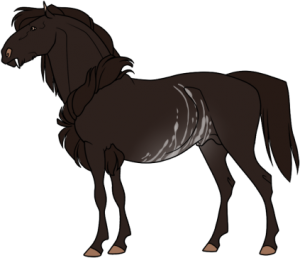
When accompanied by Rabicano, Archetain migrates to the belly region. Instead of it’s normal horizontal stripes, the stripes run vertically, with a slightly roaned look to them. Depending on the base variant of Archetain, the stripes may look different than this example.
The only exception to this is the AtnAtn variant Smoke, which is recessive to all paint/white genes. Rabicano will appear normally over top of the Smoke pattern.
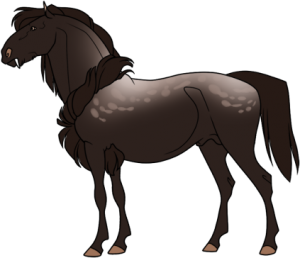
Normal roan (nR) and Varnish Roan (nLp) will cause the Archetain stripes to be contained on the topline area, and about halfway down the body. The stripes turn a roaned color, and may have corn spots. Varnish Roans may have small appaloosa-like dots around the roaning.
This does not apply to Reverse Roan. Reverse roan will appear normally.
Roan + white markings or clownfish will cause roan to act normally, with some roaning on the Archetain possible.
Roan + Other genes that causes change in the appeareance of Archetain will cause the stripes to ‘roan out’ in some places.
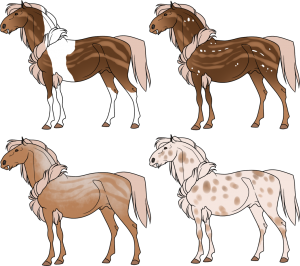
Smoke is the weakest Archetain pattern, as it is assumed to be a defect. It adheres itself to the base coat and only interacts with a few genes.
Smoke is more like an advanced, more intricate Sooty. Smoke will be covered by all EB mutations and White markings.
Dun, Sooty, and Pangare will appear beneath smoke.
Smoke does not interact with nLp + PATN genes. It will be covered by those the same way it is covered by white markings.
All paint or other nLp markings will cover it. It does not interact with Okapi, Clownfish, or dotted sooty like other forms of Archetain do.
Interactions with Appaloosa
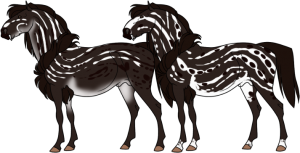
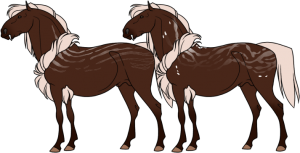
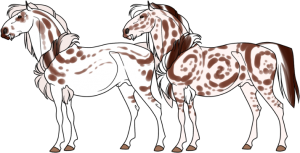
nLp(Patn1) + nAtn: Appears like almost normal nAtn expression, though it is cut out of the white. Will add more appaloosa-like spots to the design, however. There will be more white on an nAtn than a AtnAtn.
nLp(Patn1) + AtnAtn: Usually whorls cut out of white, but can be other AtnAtn designs as well. Will add significantly more spots to the design.
The only exception is the AtnAtn variant Smoke. Leopard Appaloosa will appear normally on top of Smoke.

Goes Above:
- Chrome
- Dusty
- Jester
- Merle
- Sunset
- Taffy
- Wyrm
Interacts With:
- Albino
- Appaloosa
- Clownfish
- Dominant White
- Dotted Sooty
- Melanism
- Okapi Dun
- Paint & White Markings
- Rabicano
- Roan/ Varnish Roan
Goes Below:
- Aves
- Calva
- Carey
- Fu
- Necrosis
- Oryx (All Types)
- Poecilia
- Rictus
- Tuxedo
- Veneum (Retired)
- Zebroid (Causes to be carried)
Can Go Above or Below:
- Arctos (Designer’s Choice)
